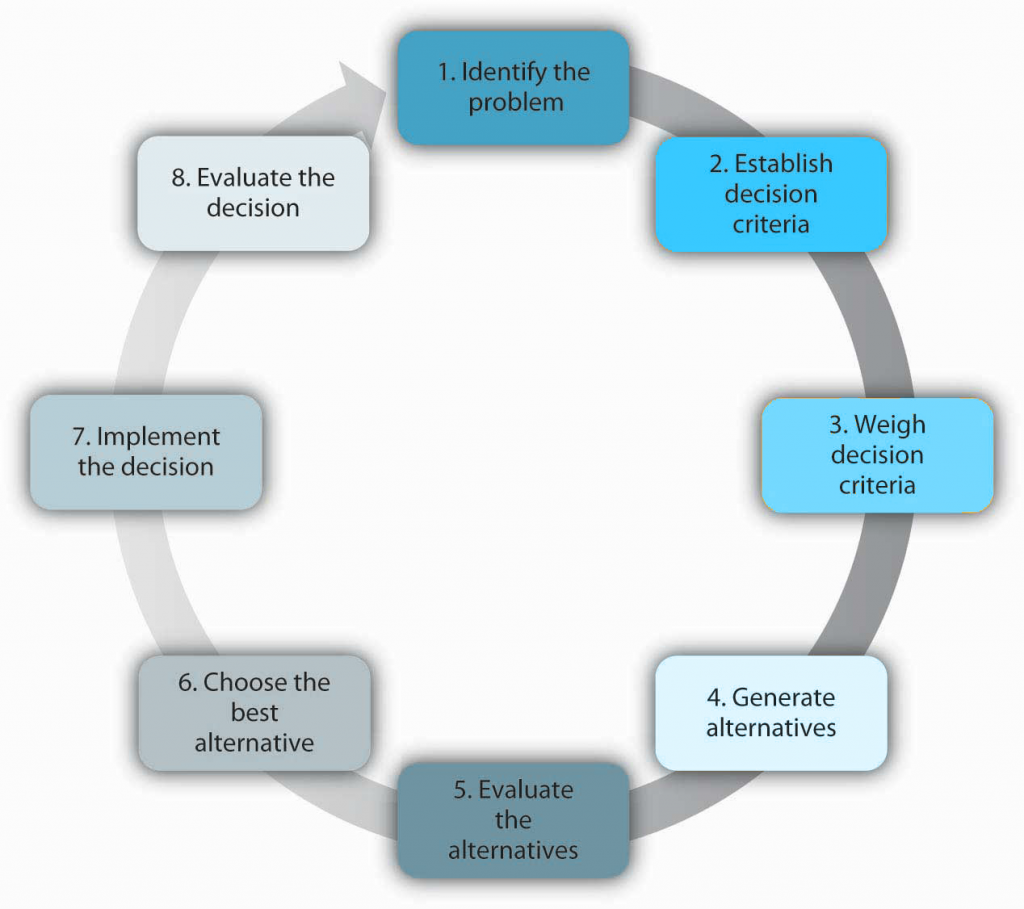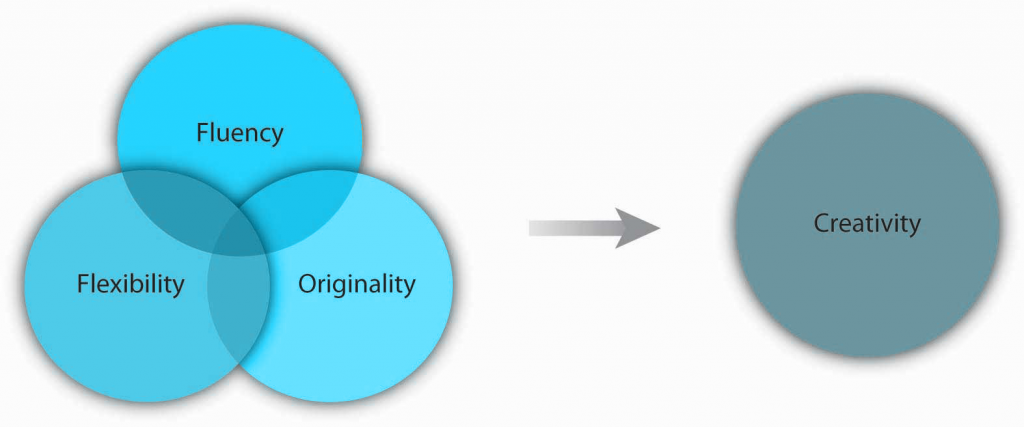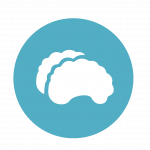7.2 Decision-making Models
Decision-making Models
In this section, we are going to discuss different decision-making models designed to understand and evaluate the effectiveness of nonprogrammed decisions. We will cover four decision-making approaches, starting with the rational decision-making model, moving to the bounded rationality decision-making model, the intuitive decision-making model, and ending with the creative decision-making model. The importance of making good decisions relates to our ability to manage our emotional intelligence to make sure we make the right decisions. These models will help us make better decisions, which results in better human relations.
In this Section:
Rational Decision-Making
The rational decision-making model describes a series of steps that decision makers should consider if their goal is to maximize the quality of their outcomes. In other words, if you want to make sure that you make the best choice, going through the formal steps of the rational decision-making model may make sense.
 Let’s Focus: Rational Decision-making Model
Let’s Focus: Rational Decision-making Model
Buying Your First Car
Let’s imagine that your old, clunky car has broken down, and you have enough money saved for a substantial down payment on a new car. It will be the first major purchase of your life, and you want to make the right choice.
The first step, therefore, has already been completed—we know that you want to buy a new car. Next, in step 2, you’ll need to decide which factors are important to you. How many passengers do you want to accommodate? How important is fuel economy to you? Is safety a major concern? You only have a certain amount of money saved, and you don’t want to take on too much debt, so price range is an important factor as well. If you know you want to have room for at least five adults, get at least twenty miles per gallon, drive a car with a strong safety rating, not spend more than $22,000 on the purchase, and like how it looks, you have identified the decision criteria. All the potential options for purchasing your car will be evaluated against these criteria.
Before we can move too much further, you need to decide how important each factor is to your decision in step 3. If each is equally important, then there is no need to weigh them, but if you know that price and mpg are key factors, you might weigh them heavily and keep the other criteria with medium importance. Step 4 requires you to generate all alternatives about your options. Then, in step 5, you need to use this information to evaluate each alternative against the criteria you have established. You choose the best alternative (step 6), and then you would go out and buy your new car (step 7).
Of course, the outcome of this decision will influence the next decision made. That is where step 8 comes in. For example, if you purchase a car and have nothing but problems with it, you will be less likely to consider the same make and model when purchasing a car the next time.

While decision makers can get off track during any of these steps, research shows that searching for alternatives in the fourth step can be the most challenging and often leads to failure. In fact, one researcher found that no alternative generation occurred in 85 percent of the decisions he studied (Nutt, 1994). Conversely, successful managers know what they want at the outset of the decision-making process, set objectives for others to respond to, carry out an unrestricted search for solutions, get key people to participate, and avoid using their power to push their perspective (Nutt, 1998).
The rational decision-making model has important lessons for decision makers. First, when making a decision, you may want to make sure that you establish your decision criteria before you search for alternatives. This would prevent you from liking one option too much and setting your criteria accordingly. For example, let’s say you started browsing cars online before you generated your decision criteria. You may come across a car that you feel reflects your sense of style and you develop an emotional bond with the car. Then, because of your love for the particular car, you may say to yourself that the fuel economy of the car and the innovative braking system are the most important criteria. After purchasing it, you may realize that the car is too small for your friends to ride in the back seat, which was something you should have thought about. Setting criteria before you search for alternatives may prevent you from making such mistakes. Another advantage of the rational model is that it urges decision makers to generate all alternatives instead of only a few. By generating a large number of alternatives that cover a wide range of possibilities, you are unlikely to make a more effective decision that does not require sacrificing one criterion for the sake of another.
Despite all its benefits, you may have noticed that this decision-making model involves a number of unrealistic assumptions as well. It assumes that people completely understand the decision to be made, that they know all their available choices, that they have no perceptual biases, and that they want to make optimal decisions. Nobel Prize–winning economist Herbert Simon observed that while the rational decision-making model may be a helpful device in aiding decision makers when working through problems, it doesn’t represent how decisions are frequently made within organizations. In fact, Simon argued that it didn’t even come close.
Think about how you make important decisions in your life. It is likely that you rarely sit down and complete all eight of the steps in the rational decision-making model. For example, this model proposed that we should search for all possible alternatives before making a decision, but that process is time consuming, and individuals are often under time pressure to make decisions. Moreover, even if we had access to all the information that was available, it could be challenging to compare the pros and cons of each alternative and rank them according to our preferences. Anyone who has recently purchased a new laptop computer or cell phone can attest to the challenge of sorting through the different strengths and limitations of each brand and model and arriving at the solution that best meets particular needs. In fact, the availability of too much information can lead to analysis paralysis , in which more and more time is spent on gathering information and thinking about it, but no decisions actually get made. A senior executive at Hewlett-Packard Development Company LP admits that his company suffered from this spiral of analyzing things for too long to the point where data gathering led to “not making decisions, instead of us making decisions (Zell et al., 2007). Moreover, you may not always be interested in reaching an optimal decision. For example, if you are looking to purchase a house, you may be willing and able to invest a great deal of time and energy to find your dream house, but if you are only looking for an apartment to rent for the academic year, you may be willing to take the first one that meets your criteria of being clean, close to campus, and within your price range.
Bounded Rationality: Making “Good Enough” Decisions
The bounded rationality model of decision making recognizes the limitations of our decision-making processes. According to this model, individuals knowingly limit their options to a manageable set and choose the first acceptable alternative without conducting an exhaustive search for alternatives. An important part of the bounded rationality approach is the tendency to satisfice (a term coined by Herbert Simon from satisfy and suffice), which refers to accepting the first alternative that meets your minimum criteria.
For example, many college graduates do not conduct a national or international search for potential job openings. Instead, they focus their search on a limited geographic area, and they tend to accept the first offer in their chosen area, even if it may not be the ideal job situation. Satisficing is similar to rational decision making. The main difference is that rather than choosing the best option and maximizing the potential outcome, the decision maker saves cognitive time and effort by accepting the first alternative that meets the minimum threshold.
Intuitive Decision-making
The intuitive decision-making model has emerged as an alternative to other decision making processes. This model refers to arriving at decisions without conscious reasoning. A total of 89 percent of managers surveyed admitted to using intuition to make decisions at least sometimes and 59 percent said they used intuition often (Burke & Miller, 1999). Managers make decisions under challenging circumstances, including time pressures, constraints, a great deal of uncertainty, changing conditions, and highly visible and high-stakes outcomes. Thus, it makes sense that they would not have the time to use the rational decision-making model. Yet when CEOs, financial analysts, and health care workers are asked about the critical decisions they make, seldom do they attribute success to luck. To an outside observer, it may seem like they are making guesses as to the course of action to take, but it turns out that experts systematically make decisions using a different model than was earlier suspected. Research on life-or-death decisions made by fire chiefs, pilots, and nurses finds that experts do not choose among a list of well thought out alternatives. They don’t decide between two or three options and choose the best one. Instead, they consider only one option at a time. The intuitive decision-making model argues that in a given situation, experts making decisions scan the environment for cues to recognize patterns (Breen, 2000; Klein, 2003; Salas & Klein, 2001). Once a pattern is recognized, they can play a potential course of action through to its outcome based on their prior experience. Thanks to training, experience, and knowledge, these decision makers have an idea of how well a given solution may work. If they run through the mental model and find that the solution will not work, they alter the solution before setting it into action. If it still is not deemed a workable solution, it is discarded as an option, and a new idea is tested until a workable solution is found. Once a viable course of action is identified, the decision maker puts the solution into motion. The key point is that only one choice is considered at a time. Novices are not able to make effective decisions this way, because they do not have enough prior experience to draw upon.
Creative Decision-making
In addition to the rational decision making, bounded rationality, and intuitive decision-making models, creative decision making is a vital part of being an effective decision maker. Creativity is the generation of new, imaginative ideas. With the flattening of organizations and intense competition among companies, individuals and organizations are driven to be creative in decisions ranging from cutting costs to generating new ways of doing business. Please note that, while creativity is the first step in the innovation process, creativity and innovation are not the same thing. Innovation begins with creative ideas, but it also involves realistic planning and follow-through. Innovations such as 3M’s Clearview Window Tinting grow out of a creative decision-making process about what may or may not work to solve real-world problems.
The five steps to creative decision making are similar to the previous decision-making models in some keys ways. All the models include problem identification, which is the step in which the need for problem solving becomes apparent. If you do not recognize that you have a problem, it is impossible to solve it. Immersion is the step in which the decision maker consciously thinks about the problem and gathers information. A key to success in creative decision making is having or acquiring expertise in the area being studied. Then, incubation occurs. During incubation, the individual sets the problem aside and does not think about it for a while. At this time, the brain is actually working on the problem unconsciously. Then comes illumination, or the insight moment when the solution to the problem becomes apparent to the person, sometimes when it is least expected. This sudden insight is the “eureka” moment, similar to what happened to the ancient Greek inventor Archimedes, who found a solution to the problem he was working on while taking a bath. Finally, the verification and application stage happens when the decision maker consciously verifies the feasibility of the solution and implements the decision.

 Here’s an Example
Here’s an Example
A NASA scientist describes his decision-making process leading to a creative outcome as follows: He had been trying to figure out a better way to de-ice planes to make the process faster and safer.
After recognizing the problem, he immersed himself in the literature to understand all the options, and he worked on the problem for months trying to figure out a solution. It was not until he was sitting outside a McDonald’s restaurant with his grandchildren that it dawned on him.
The golden arches of the M of the McDonald’s logo inspired his solution—he would design the de-icer as a series of Ms. This represented the illumination stage. After he tested and verified his creative solution, he was done with that problem, except to reflect on the outcome and process.
How do you know if your decision process is creative?
Researchers focus on three factors to evaluate the level of creativity in the decision-making process. Fluency refers to the number of ideas a person is able to generate. Flexibility refers to how different the ideas are from one another. If you are able to generate several distinct solutions to a problem, your decision-making process is high on flexibility. Originality refers to how unique a person’s ideas are.

Some experts (Amabile, 1999; Amabile et al., 1996; Ford et al., 2000; Tierney et al., 1999; Woodman et al., 1993) have proposed that creativity occurs as an interaction among three factors: people’s personality traits (openness to experience, risk taking), their attributes (expertise, imagination, motivation), and the situational context (encouragement from others, time pressure, physical structures). For example, research shows that individuals who are open to experience, less conscientious, more self-accepting, and more impulsive tend to be more creative (Feist, 1998).
 Consider This
Consider This
Ideas for Enhancing Creativity in Groups
Some ideas for enhancing creativity in groups include:
Team Composition
- Diversify your team to give them more inputs to build on and more opportunities to create functional conflict while avoiding personal conflict.
- Change group membership to stimulate new ideas and new interaction patterns.
- Leaderless teams can allow teams freedom to create without trying to please anyone up front.
Team Process
- Engage in brainstorming to generate ideas. Remember to set a high goal for the number of ideas the group should come up with, encourage wild ideas, and take brainwriting breaks.
- Use the nominal group technique (see Tools and Techniques for Making Better Decisions below) in person or electronically to avoid some common group process pitfalls. Consider anonymous feedback as well.
- Use analogies to envision problems and solutions.
Leadership
- Challenge teams so that they are engaged but not overwhelmed.
- Let people decide how to achieve goals rather than telling them what goals to achieve.
- Support and celebrate creativity even when it leads to a mistake. Be sure to set up processes to learn from mistakes as well.
- Role model creative behavior.
Culture
- Institute organizational memory so that individuals do not spend time on routine tasks.
- Build a physical space conducive to creativity that is playful and humorous—this is a place where ideas can thrive.
- Incorporate creative behavior into the performance appraisal process.
Sources: Adapted from ideas in Amabile, T. M. (1998). How to kill creativity. Harvard Business Review, 77-87. Gundry, L. K., Kickul, J. R., & Prather, C. W. (1994). Building the creative organization. Organizational Dynamics, 22(4), 22–37. ; Keith, N., & Frese, M. (2008). Effectiveness of error management training: A meta-analysis. Journal of Applied Psychology, 93(1), 59–69.; Pearsall, M. J., Ellis, A. P. J., & Evans, J. M. (2008). Unlocking the effects of gender faultlines on team creativity: Is activation the key? Journal of Applied Psychology, 93(1), 225–234.; Thompson, L. (2003). Improving the creativity of organizational work groups. Academy of Management Executive, 17, 96-109.
Enhancing Creative Decision-making
There are many techniques available that enhance and improve creativity. Linus Pauling (2008), the Nobel Prize winner who popularized the idea that vitamin C could help strengthen the immune system, said, “The best way to have a good idea is to have a lot of ideas.” One popular method of generating ideas is to use brainstorming. Brainstorming is a group process of generating ideas that follow a set of guidelines, including no criticism of ideas during the brainstorming process, the idea that no suggestion is too crazy, and building on other ideas (piggybacking). Research shows that the quantity of ideas actually leads to better idea quality in the end, so setting high idea quotas, in which the group must reach a set number of ideas before they are done, is recommended to avoid process loss and maximize the effectiveness of brainstorming. Another unique aspect of brainstorming is that since the variety of backgrounds and approaches give the group more to draw upon, the more people are included in the process, the better the decision outcome will be. A variation of brainstorming is wildstorming, in which the group focuses on ideas that are impossible and then imagines what would need to happen to make them possible (Scott et al., 2004).
One example of a creative decision making model is the Edward Debono model. The Edward Debono’s model of the Six Thinking Hats provides us with a different way of thinking about the way we make decisions. The six hats provide us with perspectives from six different perspectives. Similar to the rational decision making model discussed earlier, this model uses hats to represent the steps we need to follow in order to make good decisions. For example, the white hat helps us look at the facts of the situation. The red hat helps us look at the emotional aspect of the problem or solution. The black hat helps us to look at the negatives of the solution, while the yellow hat helps us think about the positives of the solution. The green hat allows us to come up with potential solutions or courses of action, while the blue hat helps us manage the process of making the decision.
 Let’s Focus
Let’s Focus
Andi and the 6 Hats: An Example
Consider the opening scenario where Andi is considering which job to accept. If she were using the six hats model, first she would look at the facts—that is, the aspects of each job offer (white hat). Then, she would look at how she feel (red hat) about each job. Next, she would look at the downsides of each job (black hat). Then, she would look at the positives of each job (yellow hat). Next, she would use the green hat to look at the job offers from a creative way and look at potential of choosing one job over another. Finally, the blue hat would cause Andi to make sure she used all hats to make a decision and, based on the data, would go ahead and make the best choice.
Which Model is Best?
Now that we’ve reviewed all four types of models for non-programmed decisions, you may be wondering: which model is best to use when I make a decision? As we’ve learned, each of these models has potential advantages and disadvantages. Figure 7.6 below offers some suggestions as to when each model is helpful based on the time/information available, the importance of the decision, and the clarity of the problem/solutions.
Table 7.2 Which decision-making model should I use?
| Decision Making Model | Use This Model When: |
|---|---|
| Rational | Information on alternatives can be gathered and quantified. The decision is important. You are trying to maximize your outcomes. |
| Bounded Rationality | The minimum criteria are clear. You do not have or you are not willing to invest much time to make the decision. You are not trying to maximize your outcome. |
| Intuitive | Goals are unclear. There is time pressure and analysis paralysis would be costly. You have experience with the problem. |
| Creative | Solutions to the problem are not clear. New solutions need to be generated, You have time to immerse yourself in the issue. |
 Let’s Review
Let’s Review
- In this section we learned about four models for nonprogrammed decision-making: rational, bounded rationality, intuitive, and creative decision making.
- Each of these can be useful, depending on the circumstances and the problem that needs to be solved.
 Exercises
Exercises
- Have you used the rational decision-making model to make a decision? What was the context? How well did the model work?
- Share an example of a decision in which you used satisficing. Were you happy with the outcome? Why or why not? When would you be most likely to engage in satisficing?
- Do you think intuition is respected as a decision-making style? Do you think it should be? Why or why not?
References
This section is adapted from:
Chapter 8: Make Good Decisions in Human Relations by Saylor Academy under a Creative Commons Attribution-NonCommercial-ShareAlike 3.0 License
Amabile, T. M. (1988). A model of creativity and innovation in organizations. In B. M. Staw & L. L. Cummings (Eds.), Research in organizational behavior (vol. 10, pp. 123–67). JAI Press.
Amabile, T. M., Conti, R., Coon, H., Lazenby, J., & Herron, M. (1996). Assessing the work environment for creativity. Academy of Management Journal, 39, 1154–84.
Breen, B. (2000, August). What’s your intuition? Fast Company, 290.
Burke, L. A., & Miller, M. K. (1999). Taking the mystery out of intuitive decision making. Academy of Management Executive, 13, 91–98.
Feist, G. J. (1998). A meta-analysis of personality in scientific and artistic creativity. Personality and Social Psychology Review, 2, 290–309.
Ford, C. M., & Gioia, D. A. (2000). Factors influencing creativity in the domain of managerial decision making. Journal of Management, 26, 705–32
Klein, G. (2003). Intuition at work. Doubleday.
Pauling, L. (n.d.). The best way to have good ideas. What Quote. Retrieved May 1, 2008, from http://www.whatquote.com/quotes/linus-pauling/250801-the-best-way-to-have.htm
Scott, G., Leritz, S, G , & Mumford, M. D. (2004). The effectiveness of creativity training: A quantitative review. Creativity Research Journal, 16, 361–88.
Nutt, P. C. (1994). Types of organizational decision processes. Administrative Science Quarterly, 29, 414–550.
Nutt, P. C. (1998). Surprising but true: Half the decisions in organizations fail. Academy of Management Executive, 13, 75–90.
Salas, E., & Klein, G. (2001). Linking expertise and naturalistic decision making. Lawrence Erlbaum Associates.
Tierney, P., Farmer, S. M., & Graen, G. B. (1999). An examination of leadership and employee creativity: The relevance of traits and relationships. Personnel Psychology, 52, 591–620.
Woodman, R. W., Sawyer, J. E., & Griffin, R. W. (1993). Toward a theory of organizational creativity. Academy of Management Review, 18, 293–321.
Zell, D. M., Glassman, A. M., & Duron, S. A. (2007). Strategic management in turbulent times: The short and glorious history of accelerated decision making at Hewlett-Packard. Organizational Dynamics, 36, 93–104.

